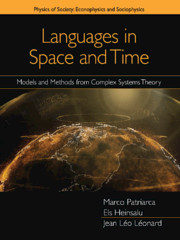Chapter 7 - Language Competition Models
Published online by Cambridge University Press: 04 June 2020
Summary
Introduction to Language Competition
The time scale of competition dynamics on which languages can be described asan analogy of competing biological species is usually shorter than that ofthe fully evolutionary dynamics. However, it is a time scale on whichlanguages can either spread or disappear and therefore is relevant for thedestiny of most of the currently existing languages (Solé et al.,2010). Competition models are technically more simple than evolutionary orcognitive models, but in a linguistic system, one first needs to identifythe competitors and the main competition processes in order to describe themwithin a competition and natural selection paradigm; this may not be astraightforward task. An example of language competition is provided by twolinguistic features competing with each other without undergoing majorchanges, for example, two different ways of pronouncing the same word or twosynonyms referring to the same object/idea. The models considered in thischapter can be categorized either as two-state models, when there aremonolinguals of language X and language Y, or as three-state models withbilinguals, where in addition to X and Y monolinguals, there is also a Zgroup of bilingual speakers. These models provide a simplified descriptionof the adoption of a new language or of the loss of a known language asabrupt changes of the state of a speaker: X→Z or Y→Z(monolingual→bilingual) transitions and the inverse Z→X orZ→Y (bilingual→monolingual) transitions. The overall processX→Z→Y (Y→Z→X) represents a language shift, theprocess whereby a community speaking a certain language X (Y) shifts tospeaking another language Y (X) because of its interaction with anotherlinguistic community.
The paradigm of language shift is extensively studied and still represents ahuge challenge for mathematical modelers. Usually, languages that areconsidered to be more prestigious expand at the expense of other languages.However, there are many possible causes behind a language shift. From ahistorical perspective, some questions have remained unanswered, puzzlinglinguists. These questions can receive at least partial answers withmathematical modeling.
Information
- Type
- Chapter
- Information
- Languages in Space and TimeModels and Methods from Complex Systems Theory, pp. 128 - 176Publisher: Cambridge University PressPrint publication year: 2020
Accessibility standard: Unknown
Why this information is here
This section outlines the accessibility features of this content - including support for screen readers, full keyboard navigation and high-contrast display options. This may not be relevant for you.Accessibility Information
- 1
- Cited by
